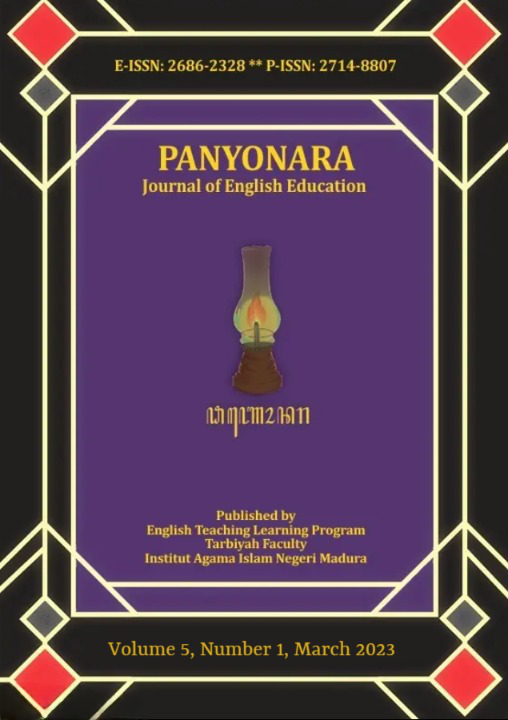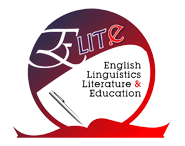Developing CISAR (Two-Mode Chain Story Cards) to Facilitate Hybrid Learning
 Abstract views: 235
,
Abstract views: 235
,
 PDF downloads: 198
PDF downloads: 198
Abstract
This research was conducted to develop learning media that can assist tenth graders in Indonesia in practicing speaking in English and improve their grammar knowledge, particularly when studying recount and narrative texts. The instructional media development was carried out using the R&D research design. The research began with investigating students’ language learning difficulties by observing them in class and interviewing their teacher. This was then followed by product development, validation and tryout before the product was finalized. The research instruments used for developing and revising the media were field notes, expert validation sheets, and a questionnaire that measured the acceptability of the media. The products developed are 56 pieces of cards named CISAR (Chain Story Cards), one teacher manual, and one student manual. Based on the results of experts’ validations, the media has met the accessibility and appropriateness criteria but required a few revisions to meet practicality requirements. Meanwhile, the small scale tryout results involving thirty-six tenth graders of a public senior high school in East Java, Indonesia, CISAR is feasible in its design, language, and has suitable material for the target users since the design considers age-appropriacy, the language is adjusted to the level of proficiency of tenth graders, and the materials follow the syllabus of tenth graders. However, improvements to the manual book were required to make the cards easier to use. Feedback given by the tryout participants confirms that the developed cards serve their intended purposes of helping tenth graders learn speaking and grammar
Downloads
References
Ambarwati, R., & Hayati, N. (2020). The Use of Picture Cards as Teaching Media to Improve Speaking Ability of Eleventh Graders: A Classroom Action Research. English Learning Innovation, 1(1). https://doi.org/10.22219/englie.v1i1.13127.
Aminudin, A. (2017). the Use of flashcard to teach speaking at the second. 20400113179.
Ayuningtias, S., & Kareviati, E. (2021). THE PREPARATION OF INSTRUCTIONAL MEDIA IN TEACHING ENGLISH TO YOUNG LEARNERS AT SDN BAROS MANDIRI 3 CIMAHI. PROJECT (Professional Journal of English Education), 4(3). https://doi.org/10.22460/project.v4i3.p414-419.
Barile, N. (2018). A Guide to Giving Clear Instructions to Students (That They Will Actually Follow). WGU. https://www.wgu.edu/.
Brown, H. D., & Lee, H. (2015). Teaching by Principle: An Interactive Approach to Language Pedagogy. New York: Pearson Education, Inc.
Brown, G., & Yule, G. (1984). Teaching The Spoken Language. Cambridge University Press.
Daloglu, A. (2020). EFL Students’ Beliefs about How They Learn Grammar Best. English Language Teaching, 13(10). https://doi.org/10.5539/elt.v13n10p158.
Frank, T. (2020, August 19). 8 Better Ways to Make and Study Flash Cards. Collegeinfogeek. https://collegeinfogeek.com/flash-card-study-tips/.
Grafwallner, P. (2017). Keeping Learning Real, Relevant, and Relatable. Edutopia. https://www.edutopia.org/article/keeping-learning-real-relevant-and-relatable.
Hagen, S. (2020). The Value of Repetition. Pearson. https://longmanhomeusa.com/blog/the-value-of-repetition/.
Hsu, C. L., Chen, Y. C., Yang, T. N., Lin, W. K., & Liu, Y. H. (2018). Does product design matter? Exploring its influences in consumers’ psychological responses and brand loyalty. Information Technology and People, 31(3). https://doi.org/10.1108/ITP-07-2017-0206.
Ilosvay, K., & Ilosway, K. (2014). Contextually Speaking: Considering Context in Teaching. Oregon English Journal, 36(2), 19–23. http://pilotscholars.up.edu/edu_facpubs/26.
Kamarulzaman, L. M., Hassan, J., & Abdul Ghani, M. T. (2020). Integrating Collaborative Learning in English Proficiency Classroom: Does It Resolve Students’ Speaking Anxiety? Sains Insani, 5(1). https://doi.org/10.33102/sainsinsani.vol5no1.188.
Kayi, H. (2006). Teaching Speaking: Activities to Promote Speaking in a Second Language. The Internet TESL Journal, XII(11), pg 1. http://www.iteslj.org.
Khonamri, F., Pavlikova, M., Ansari, F., Sokolova, N. L., Korzhuev, A. V., & Rudakova, E. V. (2020). The impact of collaborative instruction of language learning strategies on language learning beliefs and learner autonomy. XLinguae, 13(4). https://doi.org/10.18355/XL.2020.13.04.16.
Kurniatun, F., Suhartono, L., & Wardah. (2020). IMPROVING STUDENTS’ SPEAKING SKILL THROUGH ROLE PLAY ACTIVITY BY USING HAND PUPPET. Jurnal Pendidikan Dan Pembelajaran Khatulistiwa, 9, 1–9. https://doi.org/http://dx.doi.org/10.26418/jppk.v9i1.39247.
Marisah, A and Robiasih, H. (2017). THE IMPLEMENTATION OF PROJECT-BASED LEARNING TO IMPROVE VOCATIONAL STUDENTS’ SPEAKING SKILLS. Journal of English Language and Language Teaching (, 1(2).
McLaren, N., Madrid, D., & Bueno, A. (2005). TEFL in Secondary Education. Editorial Universidad de Granada.
Mujib, A., & Yunita, Y. (2021). the Effectiveness of Learning During a Pandemic Covid-19. Ri’ayah: Jurnal Sosial Dan Keagamaan, 5(02), 144. https://doi.org/10.32332/riayah.v5i02.2802.
Muliani, S., Norahmi, M., & Asi, N. (2019). THE ANALYSIS OF DIFFICULTIES IN WRITING NARRATIVE TEXT. LET: Linguistics, Literature and English Teaching Journal, 9(2). https://doi.org/10.18592/let.v9i2.3312.
Muttaqin, T. (2016). Cooperative learning and students ’ self- esteem. Journal of Educational Research, 93(February), 1–38. https://doi.org/10.13140/RG.2.1.2357.6086.
Nunan, D. (1991). Language teaching methodology: a textbook for teachers. Prentice Hall.
Pakula, H. M. (2019). Teaching speaking. Apples - Journal of Applied Language Studies, 13(1), 95–111. https://doi.org/10.17011/apples/urn.201903011691
Qomariah, S. S., & R Sudiarditha, I. K. (2017). KUALITAS MEDIA PEMBELAJARAN, MINAT BELAJAR, DAN HASIL BELAJAR SISWA: STUDI PADA MATA PELAJARAN EKONOMI DI KELAS X
IIS SMA NEGERI 12 JAKARTA. Jurnal Pendidikan Ekonomi Dan Bisnis (JPEB), 4(1). https://doi.org/10.21009/jpeb.004.1.3.
Retnowati, A. E. (2019). think-pair-share method with flashcard at grade VIIIB MTSN 6 Ngawi. 4(1), 65–78.
Saidalvi, A., & Samad, A. A. (2019). Online peer motivational feedback in a public speaking course. GEMA Online Journal of Language Studies, 19(4), 258–277. https://doi.org/10.17576/gema-2019-1904-14.
Shamsi, A. F., Altaha, S., & Gilanlioglu, I. (2019). The Role of M-Learning in Decreasing Speaking Anxiety for EFL Learners. International Journal of Linguistics, Literature and Translation (IJLLT), 2(1).
Srinivas, P. R. (2019). The Importance of Speaking Skills in English Classrooms. Alford Council of International English & Literature Journal(ACIELJ), Vol 2(Issue 2).
Sugiyono, D. (2013). Metode Penelitian Kuantitatif, Kualitatif, dan Tindakan. Alfabeta.
Supriatin, T., & Rizkilillah, V. P. (2018). TEACHING VOCABULARY USING FLASHCARD. PROJECT (Professional Journal of English Education), 1(4). https://doi.org/10.22460/project.v1i4.p479-485.
Syaifudin, M. (2019). THE USE OF FLASHCARDS TO ENHANCE STUDENT’S SPEAKING SKILL TROUGH VOCABULARY MASTERY (A Classroom Action Research for the Members of Indonusa English Club in the Second Semester of Academic Year 2016-2017). Jurnal Sainstech, 7(1).
Uktolseja, L. J., & Gaspersz, S. (2019). Implementation of chain story techniques to improve english speaking ability at imanuel YPK vocational high school, Sorong City. Journal of Education and Learning (EduLearn), 13(4). https://doi.org/10.11591/edulearn.v13i4.13327.
Ulfiah, Z. (2013). A STUDY ON THE TEACHING SPEAKING OF DESCRIPTIVE TEXT. 2007, 171–176.
Vermont. (2017). Why is proficiency-based learning important? Education Vermont. https://education.vermont.gov/sites/aoe/files/documents/edu-proficiency-based-education-why-is-proficiency-based-learning-important.pdf.
Zam Zam, F., Suriaman, A., Rofiqoh, R., & Budi, B. (2021). THE CORRELATION BETWEEN GRAMMAR AND SPEAKING SKILL OF UNDERGRADUATE STUDENTS. EXPOSURE : JURNAL PENDIDIKAN BAHASA INGGRIS, 10(2). https://doi.org/10.26618/exposure.v10i2.5676.
The journal uses an Open Access policy under a Creative Commons Attribution-NonCommercial 4.0 International License. Authors who publish with this journal agree to the following terms:
- Authors retain copyright and grant the journal right of first publication with the work simultaneously licensed under a Creative Commons Attribution License that allows others to share the work with an acknowledgment of the work's authorship and initial publication in this journal.
- Authors are able to enter into separate, additional contractual arrangements for the non-exclusive distribution of the journal's published version of the work (e.g., post it to an institutional repository or publish it in a book), with an acknowledgment of its initial publication in this journal.
- Authors are permitted and encouraged to post their work online (e.g., in institutional repositories or on their website) prior to and during the submission process, as it can lead to productive exchanges, as well as earlier and greater citation of published work.
















